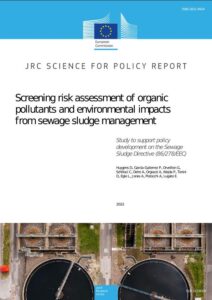 The study conducted by the JRC to support policy development on the Sewage Sludge Directive (SSD) (86/278/EEC) was made available on October 10th. This study aims to assess impacts from main sludge management routes occurring in the EU, since sludge contains valuable agricultural resources, but also contaminants that may pose risks to both human health and the environment.
The study conducted by the JRC to support policy development on the Sewage Sludge Directive (SSD) (86/278/EEC) was made available on October 10th. This study aims to assess impacts from main sludge management routes occurring in the EU, since sludge contains valuable agricultural resources, but also contaminants that may pose risks to both human health and the environment.
In the first section a long list of assessed chemicals takes into account both well-known contaminants (e.g., PAH and PFAS) and contaminants of more emerging concern, with the study mainly focusing on organic compounds, thus excluding metals (already covered by the SSD). The JRC defined risk characterisation for different pollutants through the development of a risk screening model, however data gaps made it unviable for many compounds. The outcomes of the study show that a relatively small number of pollutants can pose serious risks to both humans and soil organisms, with humans found to be the more vulnerable end-point than the organisms present in the soil for the priority pollutants, due to bioaccumulation within the food chain. PAH, long-chain PFAS, short and mid-chain polychlorinated paraffins, and to a lesser extent, alkylphenols, were identified as priority pollutants, most of them being already subject to use restriction and release reduction provision under the EU chemicals legislation (POP and REACH included). The presence of microplastics and antimicrobial resistant genes in the sludge can also be sources of threat for human health.
Impact on climate change and Soil organic matter
The impact of sewage sludges management routes (including composted and digested sludge) on the climate was also assessed, together with their climate mitigation and adaptation potential. Despite uncertainties associated with the technologies applied and emission variations across local geographic contexts, results indicate that land-spreading both untreated and treated sludge leads to net negative global worming impacts thanks to the partial displacement of mineral fertiliser and energy production, while landfilling shows the worst performance by contributing to climate change due to methane leakages. The study further underlines that carbon sequestration is higher for digested and composted sludge than for dewatered sludge, but it has to be considered that biological sludge processing methods significantly reduce the carbon loads of the materials applied to land, concluding that the potential for carbon sequestration is still larger for untreated sewage sludge than for composted and digested sludge. Still, uncertainty analysis indicates that the carbon footprint of a single pathway may fluctuate substantially consequently altering its overall performance ranking. In this regard, compost present the lowest uncertainty related to global warming potential. The document confirms that sewage sludge contributes to increase soil organic matter and consequently retain moisture and limit runoff of nutrients, but to a lesser extent compared to bio-waste. A qualitative assessment also indicates that sewage sludge can be an important source of phosphorus recovery, crucial in view of reducing the EUs dependence on imported P fertilisers and rock phosphate.
Overall, it is concluded that the application of a mix of established and innovative techniques may help to maximise benefits and minimise adverse impacts on the different sustainability dimensions affected by sludge management within the EU. Although the study serves as a basis for the revision of the Sewage Sludge Directive, the Commission is unlikely to review it in the foreseeable future.
Click here to access the full document.
